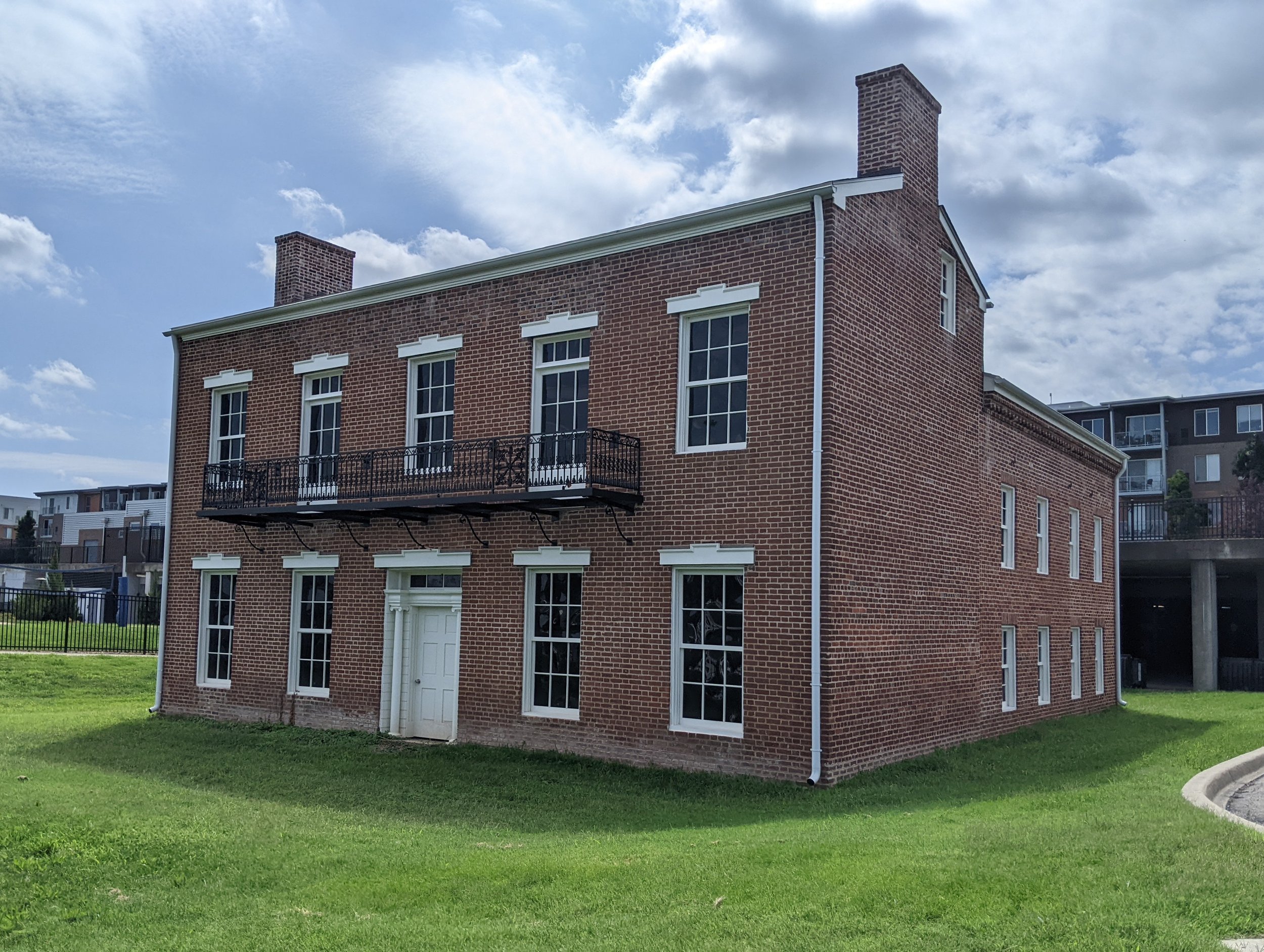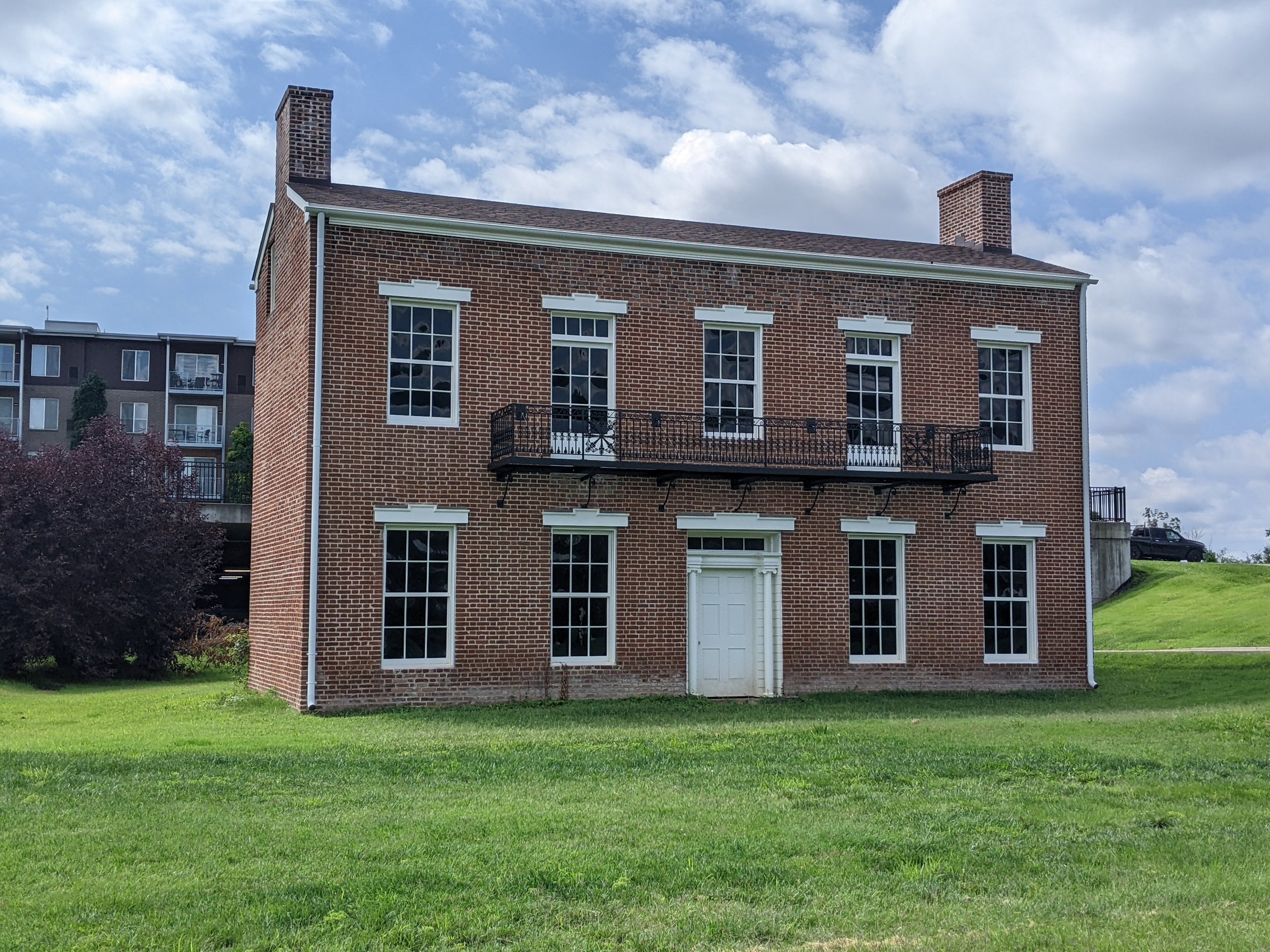Historic Paget House On River Road Finally Gets Long-Awaited Facelift
The Paget House finally got its facelift. Photos by Kevin Gibson
This story was originally published by LEO Weekly.
The old red mansion sat for decades on the Ohio River east of downtown, slowly decaying. It was the last building standing from a historic neighborhood that ultimately was swept away in the wake of the 1937 flood.
But the Paget House, built in 1838, today looks shiny and new. The former family home, which once held the address 1562 Fulton St., sits behind the RiverPark Place apartment and condo complex on River Road in the same spot it was originally built, defying time, weather and wear.
On many occasions, I’ve walked my dog Atticus from our Clifton home down along Beargrass Creek to where the old building withered behind chain-link fencing. In photos I took just a year and a half ago, the red bricks look faded and tired and a section of one wall looked to have partially caved in above a side window. Remnants of an original wrought-iron balcony hung flimsily on the building’s façade.
But over the past year or so, the old house was restored as part of the Waterfront Development Corporation’s plans to completely redevelop the Louisville waterfront — plans that began back in the 1980s. Steve Wiser, a local architect and historian who served on the corporation’s Design and Review Board, has been following plans and progress of the building’s renovation ever since.
Why is the building important to local history? Plenty of reasons. For one, the back half of the structure dates to sometime in the 1790s, making it one of the oldest buildings in Louisville. For another, when the front part of what would become a mansion was added, it was done so by the great-great niece of America’s first president, George Washington.
It was 1838 that Margaret Wright Paget hired a carpenter named Jeremiah Hollingshead to add on to the structure; records from the National Register of Historic Places indicate that she had the addition built specifically to rival some of the most beautiful homes in the city.
Back when the Point still existed, Fulton Street was often referred to as “Frenchman’s Row” due to the many New Orleans residents owning mansions there. Ms. Paget’s mansion was a red brick Georgian-style structure that matched the original building, complete with the front-facing cast-iron balcony; with a perfect view of the river, the balcony was the home’s distinguishing feature.
Most Louisvillians are familiar with the Heigold Façade, which is the only other surviving structure that once called The Point home. In fact, Paget House — also sometimes called “Mansion House” — once was situated just around the corner from the Heigold Mansion; the façade was moved first to Thurston Park and then to the foot of Frankfort Avenue in 2007 and is now a local hotspot for photo opportunities. (Note: If you’re getting your engagement photos and band photos taken by the Heigold Façade, you might be a Louisville cliché.)
The Point itself is an often-forgotten part of Louisville’s interesting history. The neighborhood thrived in the city’s early decades, made up largely of stately mansions, many of them owned by rich Southerners who spent their winters in New Orleans and would come to Louisville to ride out grueling summers.
The Point also existed on a peninsula at the time. While today Beargrass Creek spills into the Ohio River just east of the RiverPark Place marina, until the 1850s, it emptied into the Ohio River downtown near where the George Rogers Clark Bridge stands today. Until that juncture — the city turned the original route into a sewer — The Point was a peninsula that was accessible by bridge, setting apart physically from the main part of the city much as it was set apart financially.
Ms. Paget unfortunately was only able to enjoy her newly-built mansion for four years, as she died in 1842, and the mansion fell to her heirs. The house changed hands repeatedly over the next century, at one point being known as the Riverview Boat Club, and the interior was extensively remodeled to change its function as a place for community events and meetings.
Sadly, for The Point, floods in the 1880s and again in 1913 took their toll on the buildings and the residents alike, and more and more people left. The 1937 Great Flood was essentially the last stand (although the fact Paget House withstood the flooding remains a testimony to Hollingshead’s work). The city purchased the land and most of the buildings were destroyed. Paget House remained but was abandoned in the 1970s, Wiser said, which is when it began to decay.
Today, Paget House has a fresh look, back to its bright red shine, complete with a rebuild to parts of the original building, new roofing, gutters and a replica of the original balcony. (Wiser said the original balcony had found a home at Joe Ley’s Antiques, but that it has disappeared in the wake of the antique store’s closure.) But at least the mansion itself remains.
“Now we’ve got it back,” Wiser, who referred to himself as the “squeaky wheel” in the city’s efforts to restore the home, said of Paget House. And while the interior hasn’t been touched, he said it’s possible one day it can receive further restoration. Until then, even another Great Flood shouldn’t budge the old building that has haunted the river’s edge for almost as long as Louisville has existed.
“It’s good to go for another 100 years or so,” Wiser said. “Hopefully longer.”
To view Paget House, simply enter the parking lot on the left side of RiverPark Place from River Road; the mansion is to the right near the back of the parking lot. There also is an information board Waterfront Development Corporation has placed in front of the mansion to offer visitors a peek at some of its history.





